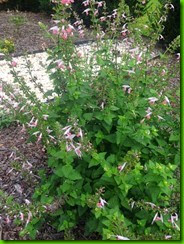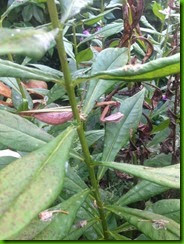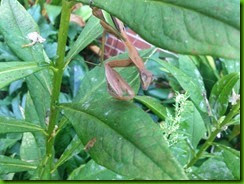My mother has fed dozens of greedy hummingbirds from her back porch every summer for years. She makes her own hummingbird food from sugar and water, and she fills 6-8 large feeders every other day, using about ten pounds of sugar a week, during the birds’ busiest time.
I used to feed the hummingbirds at my house, but I had difficulty flipping over the feeder without spilling the food and leaving a sticky trail on the porch. When my mother goes out of town, she asks her neighbor to feed the hummingbirds in her absence because the birds become emphatically demanding about their need for more food. I don't need the responsibility of feeding any other critters.
 |
| Salvia 'Black and Blue' |
To attract hummingbirds to my yard without having to fill feeders, I plant flowers that give them natural food. Hummingbirds love flowers with tubes into which they can insert their beaks to slurp out the nectar. Although they may prefer red flowers, they feed from almost any flowers that are tubular. Phlox, salvia, agastache, bee balm, butterfly bush, lantana, and red columbine (although in our climate it may finish blooming before the hummingbirds arrive) are some perennials that attract the birds. They also like honeysuckle, trumpet vine, and red Cardinal Climber, although those can be invasive in our area.
 |
| Salvia |
Earlier in the summer, my girls and I sat on the porch with my parents, shelling peas and watching the hummingbirds. When we traverse the porch, we watch out for torpedoing hummingbirds; they shoot from their hiding place in a large cedar tree to the feeders and across the porch. Many times one has missed hitting my head by inches. The birds communicate by chirping, which is quite a cacaphony when 20 or more birds are talking at once.
Over the din, I heard a different sort of chirping which was more frantic than usual. I waded into the flowerbeds to investigate, and I found an enormous praying mantis, five to six inches long and with an abdomen as thick as my thumb, holding a hummingbird in its forelegs, and biting it with its mouthparts. Evidently, the hummingbird decided to rest on the phlox plan on which the mantis sat, and the insect grabbed it. The hummingbird squealed in pain and fear as the mantis ripped at its feathers.
 |
| The 6 inch long monster |
hummingbird food, or to suck some nectar from a flower. As we watched, it opened its eyes fully, and then began to hold up its head. After about 10 minutes, it flew away while we were not watching it.
 |
| While I took this photo, I worried that it might attack me! |
If you want to add plants that attract hummingbirds, fall is a great time to plant perennials. Many garden centers are beginning to put their perennials and shrubs on clearance sale to get rid of them before the winter. I don't know how to attract monster mantises, and I'm not sure I want to learn.
 |
| Eastern Lubber grasshopper |